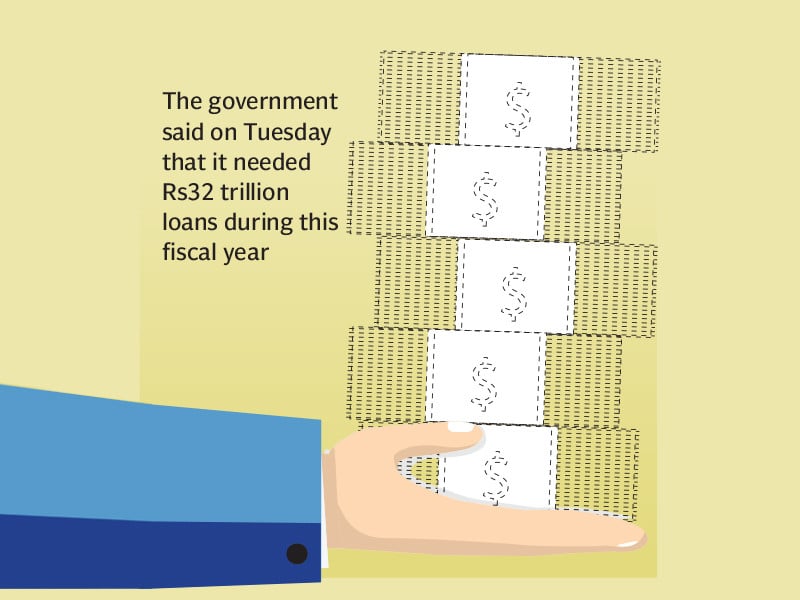
The government announced on Tuesday that it will need Rs32 trillion in loans this fiscal year, including rollovers from foreign banks and bilateral lenders. The success of this plan hinges on the timely approval of the International Monetary Fund (IMF) programme and the continued financial support from China.
The Ministry of Finance released its annual borrowing plan for fiscal year 2024-25, revealing that Pakistan is once again relying heavily on rolling over maturing debts—a strategy that has deepened the nation’s debt burden. According to the ministry, Pakistan will require Rs8.5 trillion to finance its budget deficit and an additional Rs23.4 trillion to repay maturing debt.
The annual borrowing plan outlines the government's strategy to meet its Gross Financing Needs (GFN), which include both the fiscal deficit and debt maturities. The Debt Management Office prepared the annual borrowing plan.
The total Rs32 trillion in debt requirements for the federal government does not include Rs2.6 trillion that the State Bank of Pakistan (SBP) needs to meet its obligations. The central bank must also settle $3.7 billion in debt owed to the United Arab Emirates, $4.2 billion in Chinese trade finance, and $900 million in maturing IMF debt, which together amount to Rs2.6 trillion.
Successive governments have preferred to roll over maturing debt obligations, which has not only increased the cost of interest payments but also contributed to the overall rise in annual gross financing needs. For the 2024-25 fiscal year, the estimated gross financing needs of Rs32 trillion are equivalent to 26% of GDP, excluding obligations related to the central bank. For a country like Pakistan, gross financing needs above 15% of GDP are considered unmanageable.
The finance ministry’s borrowing plan is heavily dependent on the timely approval of the IMF programme and China’s willingness to roll over nearly $7.9 billion in debt, which includes $4 billion in cash deposits and $3.9 billion in foreign commercial loans.
Finance Minister Muhammad Aurangzeb had claimed that the IMF would approve Pakistan’s $7 billion bailout package by the end of August. However, the IMF’s schedule through August 30 does not yet include Pakistan, putting the minister’s credibility on the line.
The annual borrowing plan showed that Rs8.5 trillion is needed for budget deficit financing, with 92% of this amount expected to come from domestic sources. Only 8% of budget financing, or Rs666 billion, will be sourced from foreign loans, a significant drop from the historical 20% provided by foreign lenders.
The government faces challenges in securing timely rollovers of foreign loans, especially as it struggles to repair its economic relationship with China. Beijing has provided $4 billion in cash deposits, $3.9 billion in foreign commercial loans, and $4.2 billion in trade finance facilities, all of which mature this fiscal year. Securing timely rollovers will be a significant challenge for the finance minister.
The “government aims to refinance the foreign commercial bank loans amounting to around $3.9 billion,” according to the report.
Additionally, the finance ministry plans to raise an additional $1.2 billion in new commercial debt. However, progress has been limited to initial expressions of interest from three foreign banks, with no new deals signed due to high costs.
The government plans to roll over $4 billion in bilateral deposits from China and $5 billion from Saudi Arabia but did not mention the UAE debt, which is listed on the central bank’s balance sheet.
The government also intends to raise around $1 billion through the issuance of Panda Bonds in the Chinese capital markets and Green Bonds in international markets. Joint financial advisors include China Development Bank, China International Capital Corporation, Habib Bank Limited, and CitiBank.
The plan is to carry out issuance of a Panda Bond with an amount equivalent to $300 million and another $700 million will be tapped through the global green bond.
The finance ministry also plans to take three budget support loans totalling $800 million from the Asian Development Bank (ADB). Key multilateral loans for 2025 from the ADB include a $400 million Climate and Disaster Resilience Enhancement Programme, $100 million for Women Inclusive Finance, and $300 million for Domestic Resource Mobilisation.
The Debt Office warned that the Rs32 trillion borrowing plan is subject to potential variations due to domestic and international macroeconomic conditions and debt market dynamics.
The government plans to carry out zero net issuance through treasury bills this fiscal year, refinancing maturing loans through long-term government securities, such as Pakistan Investment Bonds and Government Ijara Sukuk. To manage floating rate debt exposure, the government aims to increase the issuance of fixed-rate debt securities in line with medium-term debt strategy targets.
















1730706072-0/Copy-of-Untitled-(2)1730706072-0-270x192.webp)
COMMENTS
Comments are moderated and generally will be posted if they are on-topic and not abusive.
For more information, please see our Comments FAQ